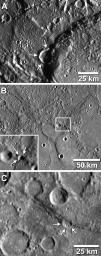
|
Craters Deformed and Shortened
- Click the image above for a larger view
- Full-Res JPEG (504 x 1280) (127.6 kB)
- Full-Res TIFF (504 x 1280) (646.0 kB)
Caption:
Numerous examples of craters that have been deformed and shortened by younger faults have been identified on images returned from MESSENGER's first flyby of Mercury. In three cases shown here (arrows), portions of the floor and rim of a crater were buried when a large block of crust was thrust over the crater during the formation of a prominent fault scarp or cliff. By comparing the estimated size and shape of the original, undeformed crater with the crater's current geometry, scientists can infer the amount of movement between the two crustal blocks on either side of the fault. This figure was recently published in Science magazine. For each of the three examples of deformed and shortened craters shown here, movement on the faults buried at least a kilometer of the original crater. A: 17-kilometer (11-mile) diameter crater (arrows) shortened by Beagle Rupes. B: 5-kilometer (3-mile) diameter crater deformed near the rim of an older, larger crater, shown enlarged in the box on the lower left. C: 11-kilometer (7-mile) diameter crater (arrows) shortened by a northwest-southeast-trending fault scarp.
Background Info:
These images are from MESSENGER, a NASA Discovery mission to conduct the first orbital study of the innermost planet, Mercury. For information regarding the use of images, see the MESSENGER image use policy .
Cataloging Keywords:
| Name | Value | Additional Values |
|---|---|---|
| Target | Mercury | |
| System | ||
| Target Type | Planet | |
| Mission | MESSENGER | |
| Instrument Host | MESSENGER | |
| Host Type | Orbiter | |
| Instrument | Mercury Dual Imaging System (MDIS) | |
| Detector | ||
| Extra Keywords | Crater, Grayscale | |
| Acquisition Date | ||
| Release Date | 2008-07-23 | |
| Date in Caption | ||
| Image Credit | NASA/Johns Hopkins University Applied Physics Laboratory/Arizona State University/Carnegie Institution of Washington. Figure 3 from Solomon et al., Science, 321, 59-62, 2008. | |
| Source | photojournal.jpl.nasa.gov/catalog/PIA10984 | |
| Identifier | PIA10984 | |
